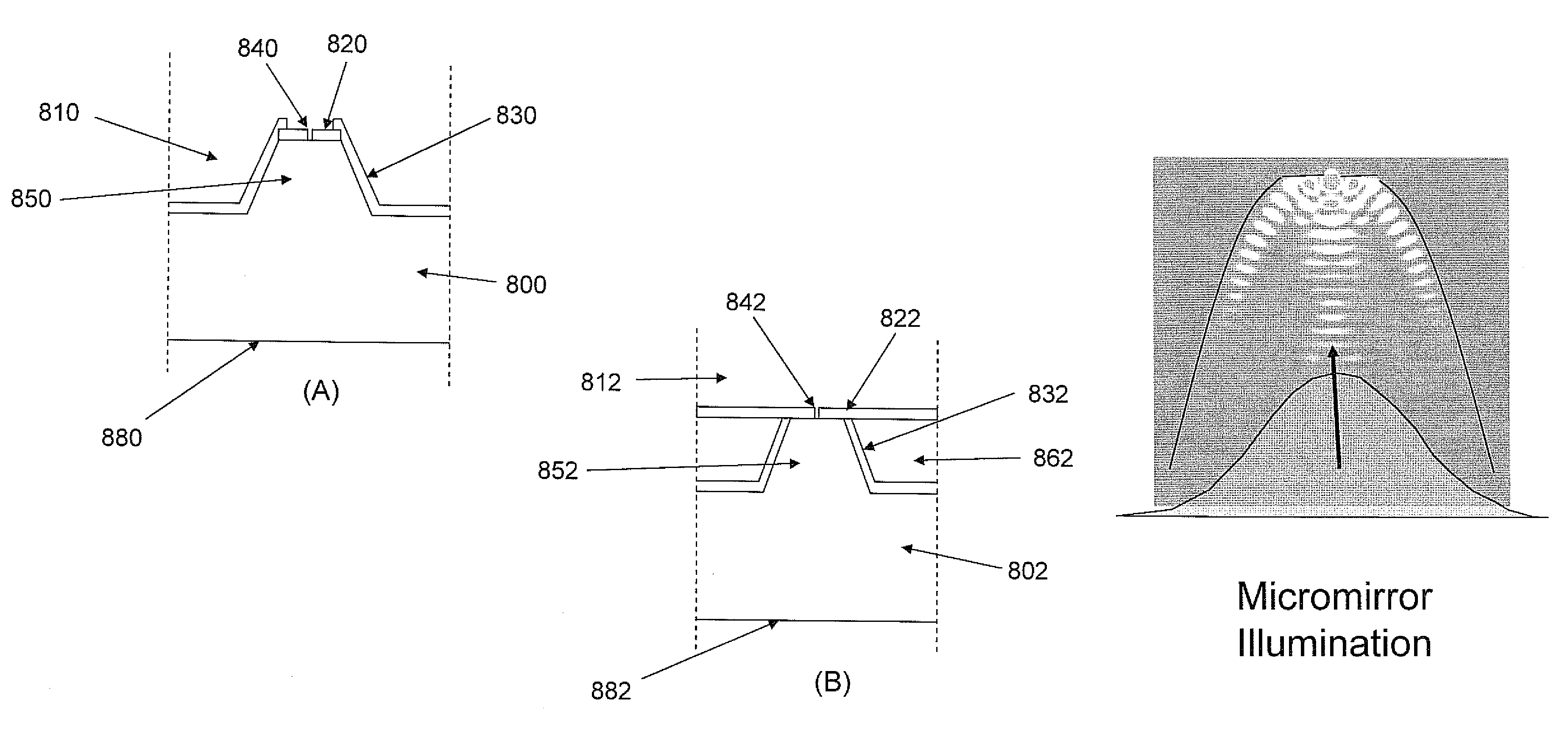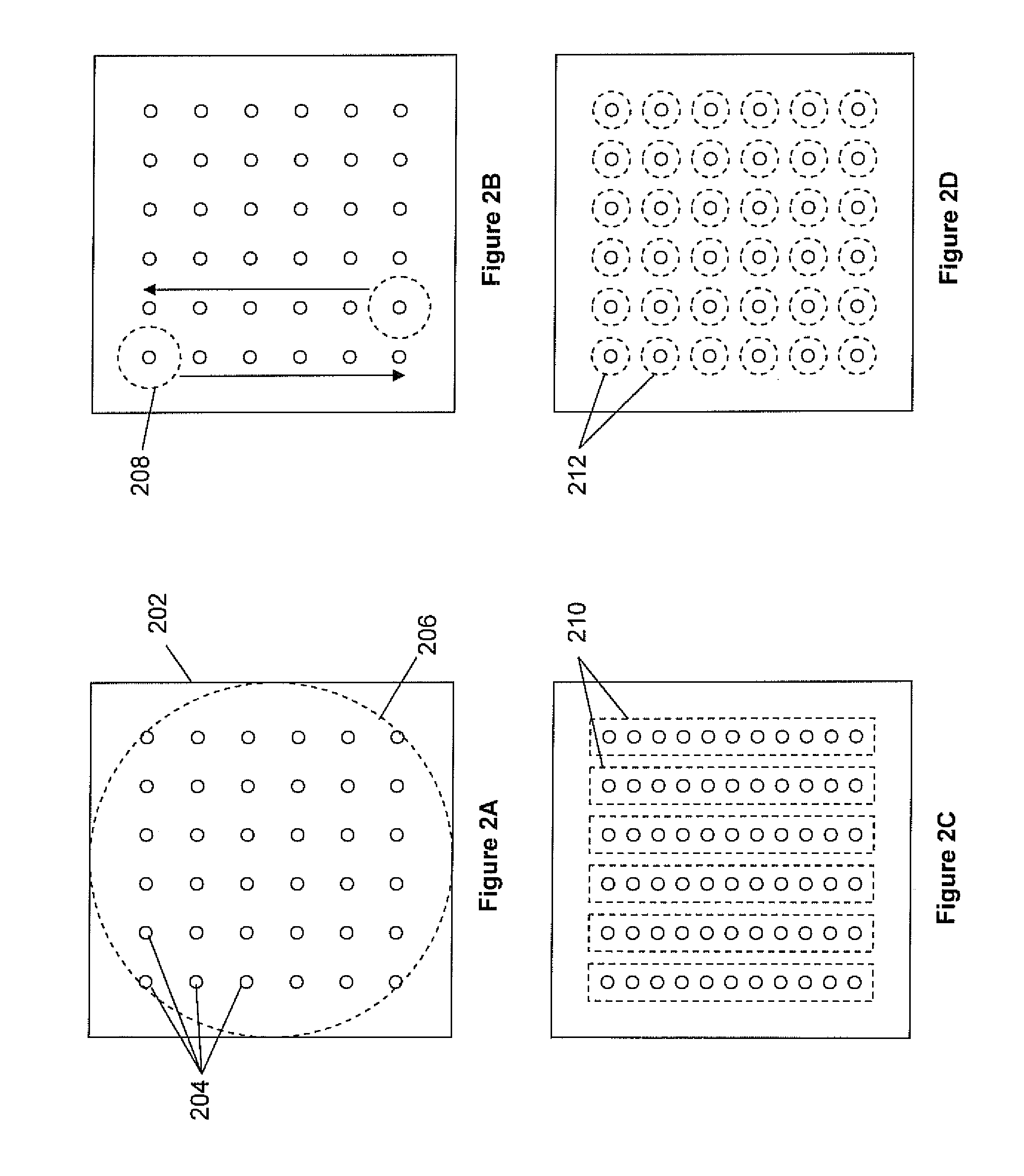Ultra-high multiplex analytical systems and methods
a technology of multiplex analysis and high multiplex, applied in the field of ultra-high multiplex analysis systems and methods, can solve the problems of reducing the signal to noise ratio resulting from either or both of lower signals, and increasing the difficulty of multiplex analysis
- Summary
- Abstract
- Description
- Claims
- Application Information
AI Technical Summary
Benefits of technology
Problems solved by technology
Method used
Image
Examples
example 1
Parabolic Mirror Substrates
[0206]Substrates were fabricated having zero mode waveguides disposed through a metal layer that was deposited over a parabolic feature defined in a glass substrate. The devices were fabricated according to the process set out in FIG. 10 and the accompanying description, except that subsequent planarization of the substrate was not carried out (steps V-VII). The aperture through the metal layer which defines the core of the zero mode waveguide was fabricated using a focused ion beam (FIB etch process) to define a core of approximately 120 nm in diameter. The resulting structure is shown in FIG. 31A, under scanning electron microscopy (SEM), imaged from the metal layer side of the structure. The core of the zero mode waveguide is visible as the opening in the center top of the structure.
[0207]A comparison substrate was also provided having a zero mode waveguide of approximately the same cross sectional dimensions disposed in a planar metal layer over a plan...
example 2
Theoretical Modeling of Conical Mirror Substrates
[0208]Structures were modeled using the various components illustrated in FIGS. 32 and 33, respectively. For example, with respect to the straight conical structure illustrated in FIG. 32, dimensions were set as follows: d1=1.25 μm; d2=5 μm and h=4.69 μm. The model assumed that an objective lens used to collect emitted light from the substrate / reflector component has a numerical aperture of 0.5 with a highest collection angle of + / −20 degrees with respect to the optical axis, thereby providing a collection angle with respect to the bottom surface of the substrate of from 70 to 110 degrees. Based upon the conical model shown in FIG. 32, the ray angle that is reflected out of the cone is from 43.58 (Θtr) to 105.52 (Θbr) degrees.
[0209]For the two staged conical reflector shown in FIG. 33, the dimensions were set to: d1=1.25 μm; d2=3 μm; d3=5 μm; h1=1 μm; and h2=3.69 μm. In this case, the ray angle that is reflected and comes out of the r...
example 3
Production of Array of Nanoscale Reaction Regions on Micromirror Structures Using Sacrificial Pillars
[0211]Polygermanium was deposited onto fused silica as a 500 nm layer by LPCVD at 350° C. Pillars were etched into a polygermanium using a 248 nm stepper, Lam etcher, width tuning from 300 nm to 120-150 nm. Mirrors were etched using a 248 nm stepper and Centura-MXP etcher. The array was then annealed at 600° C. to reduce autofluorescence and outgass the organic contaminants, followed by evaporation of aluminum and de-capping (removal of the polygermanium) in wet solution (30% H202 at 50° C.) without attacking aluminum on mirror facets. FIG. 34 shows an SEM micrograph showing a portion of the array of reaction regions with associated micromirrors. FIG. 35 shows a single micromirror structure having a reaction region on its top. FIG. 36 shows a nanoscale reaction region on the top of a micromirror structure.
PUM
| Property | Measurement | Unit |
|---|---|---|
| diameters | aaaaa | aaaaa |
| diameters | aaaaa | aaaaa |
| diameters | aaaaa | aaaaa |
Abstract
Description
Claims
Application Information
 Login to View More
Login to View More - R&D
- Intellectual Property
- Life Sciences
- Materials
- Tech Scout
- Unparalleled Data Quality
- Higher Quality Content
- 60% Fewer Hallucinations
Browse by: Latest US Patents, China's latest patents, Technical Efficacy Thesaurus, Application Domain, Technology Topic, Popular Technical Reports.
© 2025 PatSnap. All rights reserved.Legal|Privacy policy|Modern Slavery Act Transparency Statement|Sitemap|About US| Contact US: help@patsnap.com



